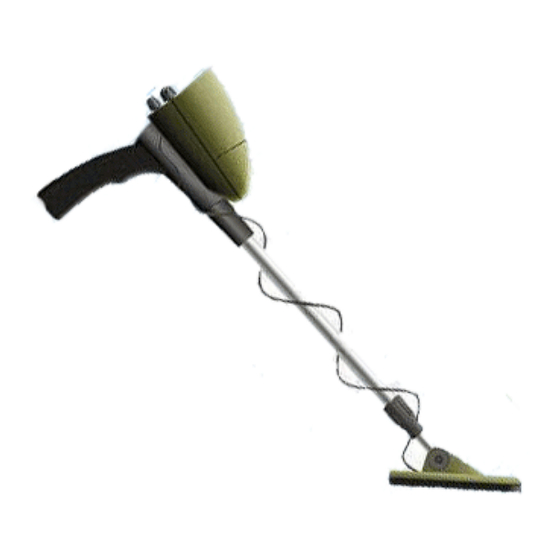
Table of Contents
Advertisement
Quick Links
Advertisement
Table of Contents

Summary of Contents for Gold Century GC-1012
- Page 1 Gold Century Metal Detector GC-1012 OPERATION INSTRUCTION...
- Page 2 FEATURES With your Metal Detector, you can hunt for coins, relics, jewelry, gold, and silver just about anywhere. This metal detector is versatile and easy to use. The detector’s features include: Earphone Jack – lets you connect earphones (not supplied) to the detector in private.
-
Page 3: Treasure Hunter's Code Of Ethics
TREASURE HUNTER’S CODE OF ETHICS All treasure hunters might be judged by the example you set. Here are a few basic rules you should follow while using your detector. Always get permission before searching any site. Respect the rights and property of others. Observe all national, state, and local laws while treasure hunting. - Page 4 3. Turn the stem’s lock nut in the reverse direction of the arrow to lock it in place. 4. Unscrew the knobs on the search coil and remove the knobs and the connector. Insert the stem and align the holes on the search coil bracket and the stem.
-
Page 5: Adjusting The Search Coil
ADJUSTING THE SEARCH COIL Loosen the knobs at the search coil’s end, then adjust the search coil to the desired angle. (The search coil should be parallel with the ground.) Tighten the knobs just enough to keep the search coil from rotating or wobbling. -
Page 6: Using Earphones
that can destroy electronic parts. If you do not plan to use the detector for a week or more, remove the battery. Dispose of old battery promptly and properly. When LOW BATT lights, replace the battery. You can extend battery life by using earphones, which require less power than the built-in speakers. -
Page 7: Operation
To protect your hearing, follow these guidelines when you use earphones. Set the volume to the lowest setting before you begin listening. After you begin listening, adjust the volume to a comfortable level. Do not listen at extremely high volume levels. Extended high volume listening can lead to permanent hearing loss. -
Page 8: Preparing The Detector
PREPARING THE DETECTOR Turning On the Detector Hold the detector in a comfortable position, then rotate VOLUME away from OFF to the desired sound level. Tuning the Detector TUNEING fine-tunes the balance between the detector’s receiver and transmitter circuitry to provide consistent pointer and tone indications. Follow these steps to set TUNEING. - Page 9 Indoor testing Remove any watches, rings, or other metal jewelry you are wearing, then place the detector on a wooden or plastic table. Adjust the search coil’s angle so the flat part faces the ceiling. Note: Never test the detector on a floor inside a building. Most buildings have metal of some kind in the floor, which might interfere with the objects you are testing or mask the signal completely.
- Page 10 Outdoor Testing and use Find an area on the ground outside where there is no metal. Place a sample of the material you want the detector to find (such as a gold ring or a coin) on the ground. (If you are using valuable metal such as gold to test the detector, mark the area where you placed the item, to help you find it later.
-
Page 11: Fine-Tuning The Detector
the search coil cover the target a few times, the target is probably junk metal. False signals can be caused by trashy ground, electrical interference, or large irregular pieces of junk metal. False signals are usually broken or non-repeatable. Try finding other metal in the area. When you find a metal item, wait a few seconds after the tone stops before continuing, to allow the detector time to reset (or, press the PUSH button to return the pointer to the center of the view meter and the... -
Page 12: False Signals
FALSE SIGNALS Because your detector is extremely sensitive, trash-induced signals and other sources of interference might cause signals that seem confusing. The key to handling these types of signals is to dig for only those targets that generate a strong, repeatable signal. As you sweep the search coil back and forth over the ground, learn to recognize the difference between signals that occur at random and signals that are stable and repeatable. - Page 13 Sometimes, targets are difficult to accurately locate due to the sweep direction. Try changing your sweep direction to pinpoint a target. Follow these steps to pinpoint a target. When the detector detects a buried target, continue sweeping the search coil over the target in a narrowing side-to-side motion. Make a visual note of the exact spot on the ground where the detector beeps.
-
Page 14: Troubleshooting
TROUBLESHOOTING If your detector is not working as it should, follow the suggestions below to see if you can eliminate the problem. Problem Suggestions The detector displays or You might be sweeping the detector’s sounds false signals. search coil too fast or at the wrong angle. - Page 15 The following suggestions will help you care for your metal detector so you can enjoy it for years. Keep the metal detector dry. If it gets wet, wipe it dry immediately. Liquids might contain minerals that can corrode the electronic circuits.
- Page 16 Warranty This product is warranted against defects in materials and workmanship for 1 year from date of purchase. The item must be shipped at buyer’s expense to our offices where we will, at our discretion, repair or replace it free of charge. Please include your original purchase receipt.






Need help?
Do you have a question about the GC-1012 and is the answer not in the manual?
Questions and answers